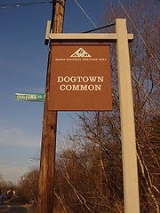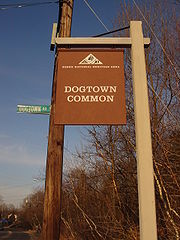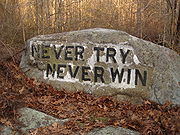
Dogtown, Massachusetts
Encyclopedia

Cape Ann
Cape Ann is a rocky cape in northeastern Massachusetts on the Atlantic Ocean. The cape is located approximately 30 miles northeast of Boston and forms the northern edge of Massachusetts Bay. Cape Ann includes the city of Gloucester, and the towns of Essex, Manchester-by-the-Sea, and...
in Massachusetts
Massachusetts
The Commonwealth of Massachusetts is a state in the New England region of the northeastern United States of America. It is bordered by Rhode Island and Connecticut to the south, New York to the west, and Vermont and New Hampshire to the north; at its east lies the Atlantic Ocean. As of the 2010...
. Once known as the Common Settlement and populated by respectable citizens, the area later known as Dogtown is divided between the city of Gloucester
Gloucester, Massachusetts
Gloucester is a city on Cape Ann in Essex County, Massachusetts, in the United States. It is part of Massachusetts' North Shore. The population was 28,789 at the 2010 U.S. Census...
and the town of Rockport
Rockport, Massachusetts
Rockport is a town in Essex County, Massachusetts, United States. The population was 6,952 at the 2010 census. Rockport is located approximately 25 miles northeast of Boston at the tip of the Cape Ann peninsula...
. It is in an area not particularly suited to agriculture, due to poor and very rocky soil. Nevertheless it was settled, beginning in 1693, because its inland location afforded protection from pirates and from enemy natives. Another attraction was the fact that the area lay on what was originally the only direct land route between Sandy Bay (Rockport's original name) and Gloucester. The peak of population, from about 1750 to the turn of the nineteenth century, has been estimated at around one hundred families.
After new coastal roads were opened, and especially after the conclusion of the War of 1812
War of 1812
The War of 1812 was a military conflict fought between the forces of the United States of America and those of the British Empire. The Americans declared war in 1812 for several reasons, including trade restrictions because of Britain's ongoing war with France, impressment of American merchant...
and its attendant risk of coastal bombardment, most farmers moved away from Dogtown. Their abandoned houses were for a few decades occupied by itinerants and vagabonds, giving the area its bad reputation. Many of the widows of sea-goers and soldiers who never returned kept dogs for protection and company. As these last inhabitants died their pets became feral, roaming the moors and howling, possibly giving rise to the nickname "Dogtown." An equally likely reason for the area's name is that residents of surrounding villages considered the inhabitants of the decrepit area to live like dogs.
Some of the last occupants were suspected of practicing witchcraft
Witchcraft
Witchcraft, in historical, anthropological, religious, and mythological contexts, is the alleged use of supernatural or magical powers. A witch is a practitioner of witchcraft...
, including Thomazine "Tammy" Younger, whom some knew as the "Queen of the Witches." Tammy lived on Fox Hill, by Alewife Brook, and would reputedly place a curse on teams of oxen carrying fish from the harbor as they crossed the bridge there, unless their driver paid her a "toll". A reputed witch often associated with Dogtown was Peg Wesson, but she lived in Gloucester. The last resident of Dogtown, a freedman
Freedman
A freedman is a former slave who has been released from slavery, usually by legal means. Historically, slaves became freedmen either by manumission or emancipation ....
named Cornelius "Black Neil" Finson, was found half-dead living in a cellar-hole in the winter, and was removed to the poorhouse in Gloucester in 1830; he died shortly afterward.

Roger Babson
Roger Ward Babson , remembered today largely for founding Babson College in Massachusetts, was an entrepreneur and business theorist in the first half of the 20th century...
, is known for, among other things, his commissioning of unemployed stonecutters to carve inspirational inscriptions on approximately three dozen boulders in Dogtown during the Great Depression
Great Depression
The Great Depression was a severe worldwide economic depression in the decade preceding World War II. The timing of the Great Depression varied across nations, but in most countries it started in about 1929 and lasted until the late 1930s or early 1940s...
. Babson also mapped and numbered the cellar holes left from the homes of Dogtown's former residents.
Most of the land is held in trust by Gloucester and Rockport and is therefore protected in perpetuity. The current state of Dogtown affords rich recreation opportunities to hikers and bikers, dog-walkers, nature lovers, cross-country skiers, geologists and historians. The area is peppered with house-sized boulders, including one named "The Whale's Jaw," which it formerly resembled before collapsing after a picnic campfire got out of control in 1989.
Sources
- In the Heart of Cape Ann, or The Story of Dogtown by Charles E. Mann (Proctor Brothers, Publishers; Gloucester, Mass.), 1897
Further reading
- Dogtown Days by Eileen Day McGrath (2009), JLH Publishing. A novel set in Dogtown.
- "The Last Days of Dogtown: A Novel" by Anita Diamant (2005), Scribner. A novel set in Dogtown

